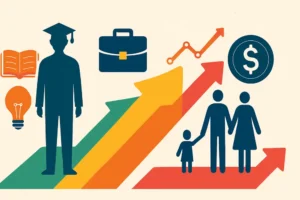High taxation squeezes India’s salaried class, cutting savings, fueling stress, and limiting lifestyle growth.
From brain drain to shrinking middle-class power, the impacts go beyond finances—reshaping society, trust in governance, and future aspirations.
Balanced reforms, financial literacy, and global comparisons highlight ways to ease burdens while ensuring fair contributions and sustainable growth.
Discover the social impacts of high taxation on salaried Indians in 2025 and explore practical solutions for financial relief, equity, and better quality of life.

What are the Social Impacts of High Taxation on Salaried Indians in 2025?
Taxation is the backbone of any economy, helping governments fund infrastructure, healthcare, education, and social welfare schemes.
In India, the salaried class forms a major chunk of tax contributors. By 2025, with inflationary pressures, rising living costs, and increasing tax burdens, salaried individuals find themselves at the heart of the nation’s fiscal ecosystem.
But what happens when high taxation collides with the realities of everyday life?
social impacts go far beyond financial spreadsheets, influencing lifestyle, family well-being, mental health, and even societal structures.
In this article, we will explore the multifaceted social impacts of high taxation on salaried Indians in 2025, blending statistics, real-life examples, and global comparisons to provide a comprehensive view.
Overview of Current Taxation in India (2025)
India follows a progressive taxation system where higher income brackets attract higher tax rates. In 2025, despite tweaks to the tax regime, the burden on salaried individuals continues to be substantial.
- Tax slabs range from 5% to 30% for individuals, with additional cess and surcharges.
- Middle-class employees (earning between ₹8 lakh and ₹20 lakh annually) are heavily impacted, as they fall into tax slabs that eat away a significant portion of their income.
- Recent policy shifts include incentives for startups and digital entrepreneurs, but relief for salaried professionals remains limited.
The average effective tax burden for middle-income earners in India hovers around 20–25% of gross income, significantly higher when adjusted for cost of living and inflation.
A recent Business Today analysis reveals that the salaried middle class now contributes more in direct taxes than all corporations combined—an unsustainable imbalance of tax burden.
Why High Taxation Matters for Salaried Indians
Unlike business owners or high-net-worth individuals who can claim multiple deductions or restructure income, salaried Indians often have limited flexibility. Their income is fixed, deductions are capped, and compliance is mandatory. This rigidity makes high taxation feel like a direct cut into their quality of life.
For many, the struggle isn’t just about paying taxes—it’s about balancing household expenses, saving for the future, and ensuring a decent standard of living.
Read Here: Income Inequality and Its Impact on Social Mobility
Social Impacts of High Taxation on India’s Middle Class
High taxation reshapes India’s middle class—affecting lifestyle, mental health, mobility, savings, and trust in governance systems.
Here are the key social impacts of high taxation on India’s middle class.
1. Lifestyle Adjustments
High taxation reduces disposable income, forcing salaried Indians to adjust their lifestyle choices:
- Cutting back on leisure activities like travel, dining out, or entertainment.
- Opting for budget-friendly alternatives in daily expenses.
- Postponing big purchases like cars or real estate.
As a result, the aspirational middle class often feels stuck, unable to move upward economically despite working hard.
2. Impact on Mental Health & Stress Levels
Financial stress is among the leading causes of anxiety in India. Business Standard (May 2025) reported that 68% of IT professionals missed out on an average of ₹49,094 in tax savings due to inefficient tax planning. This translates into:
- Higher stress at the workplace.
- Sleep disturbances and anxiety.
- A growing sense of dissatisfaction despite career growth.
The psychological toll of high taxation is invisible but deeply impactful, affecting productivity and personal well-being.
3. Effect on Family and Relationships
High taxation doesn’t just affect individuals—it reshapes family dynamics:
- Parents struggle to afford quality education for children.
- Couples delay major decisions like buying property or having children due to financial constraints.
- Elder care becomes financially stressful with limited healthcare benefits.
The middle-class Indian household, once the symbol of stability, faces increasing fragility.
4. Wealth Inequality
High taxation disproportionately affects the salaried middle class compared to ultra-rich individuals who have access to tax-saving mechanisms. According to a 2023 Oxfam India report, the wealthiest 1% now control over 40% of the country’s total wealth, while the bottom 50% hold just 3% . Combined with data showing the top 1% ring-fence 22.6% of national income and 40.1% of wealth, this growing disparity threatens social equity and mobility.
5. Migration Trends
Another social impact is the “tax-driven brain drain.” Highly skilled professionals increasingly seek opportunities in tax-friendly nations like UAE, Singapore, or even European countries with better social benefits. This migration not only weakens India’s talent pool but also creates ripple effects in families left behind. The Financial Express coverage linking high taxation with intensified brain drain concerns.
6. Entrepreneurship & Side Hustles
To combat taxation pressures, many salaried Indians turn toward side hustles or small businesses. While this fuels innovation and entrepreneurship, it also indicates a lack of satisfaction with primary earnings. Socially, this creates a culture of overwork, where individuals juggle multiple jobs to sustain living standards.
7. Political Discontent & Civic Engagement
Budget announcements and tax reforms spark intense debate and criticism. Citizens increasingly demand transparency, equity, and accountability in fiscal policy. The perception that taxes fund elite lifestyles while offering minimal returns fuels distrust.
8. Erosion of Trust in Governance and Policy
Salaried Indians often feel overtaxed and underrepresented, leading to skepticism about government spending and fiscal transparency. The perception that taxes fund elite privileges while offering minimal public returns—like poor infrastructure or healthcare—fuels civic disengagement. Budget announcements are met with criticism, and political discourse increasingly reflects middle-class discontent. This erosion of trust affects voter behavior, policy advocacy, and the legitimacy of democratic institutions.
9. Compromised Education and Skill Development
Middle-class families often struggle to afford quality education due to high taxes and limited subsidies. Private schooling, coaching, and higher education become financial burdens, especially in urban areas. This compromises skill development and access to competitive opportunities. Over time, it widens the gap between privileged and aspirational learners, affecting employability, social equity, and India’s long-term human capital growth.
Case Studies or Examples
Case Study 1: Ravi – The IT Professional
Ravi, a 32-year-old IT professional in Bengaluru, earns ₹15 lakh annually. After taxes, rent, and EMIs, he barely manages to save 8% of his income. “I feel like I’m running on a treadmill,” he says. “Working harder each year, but getting nowhere.”
Case Study 2: Sneha – The School Teacher
Sneha, a 40-year-old teacher in Delhi, struggles to provide quality education for her children. Despite steady employment, taxation leaves her with limited flexibility. “We’re forced to compromise on healthcare and extracurriculars for the kids.”
Case Study 3: Arjun – The Migrant Dreamer
Arjun, a 28-year-old engineer from Pune, moved to Dubai in 2025 after feeling frustrated with India’s tax system. He earns tax-free income abroad, sending remittances back home, but feels disconnected from his family. His story reflects the emotional and social costs of brain drain.
Case Study 4: Priya & Ramesh – The Urban Couple
Priya and Ramesh, a married couple in Hyderabad, both work in corporate jobs. Combined, they earn ₹24 lakh annually, but after taxation and expenses, they delay purchasing a home. “We’re living in a rented apartment and saving aggressively, but taxes slow down our dream of owning a house,” they share.
Case Study 5: Meera – The Healthcare Struggler
Meera, a 50-year-old administrative professional in Mumbai, cares for her elderly parents. High taxes leave her with little savings for medical expenses, pushing her to depend on loans. “It feels like I’m paying for the country but can’t afford my own family’s healthcare,” she says.
These stories reflect a broader sentiment: taxation is no longer just an economic policy—it’s a lived social experience.
Comparison with Other Countries: How India’s Tax Burden Stacks Up Globally
Globally, many developed nations impose higher taxes, but they balance it with social security, healthcare, and public infrastructure. For instance:
United States – Despite high federal taxes, numerous deductions and credits ease the burden. Disposable income remains higher than India, with tax dollars funding infrastructure, healthcare, and defense effectively.
United Kingdom – Progressive taxation supports welfare, healthcare, and pensions. While tax rates seem heavy, visible public services and social security systems create better value perception compared to India’s limited returns.
Canada – Taxes are high, but universal healthcare, parental benefits, and welfare make citizens feel supported. Indians often feel their tax money delivers less in return compared to Canada’s transparent model.
Singapore – With low personal tax rates, professionals retain more earnings. Paired with efficient governance and excellent public services, Singapore showcases how low taxation can still deliver high-quality living standards.
United Arab Emirates (UAE) – With no personal income tax, salaried workers save more. However, heavy reliance on oil revenues and VAT means this model is less sustainable compared to India’s diversified system.
Australia – Moderate-to-high taxation balances welfare, healthcare, and childcare support. Citizens see direct returns, making taxation less frustrating than in India where benefits for salaried professionals remain relatively limited.
Brazil – High taxation with inefficient public services creates resentment similar to India. Limited healthcare, corruption, and inequality highlight how weak redistribution diminishes the impact of tax burdens on society.
South Africa – High personal tax rates persist amid unemployment and inequality. Salaried workers feel squeezed as public services fail to match their contributions, echoing frustrations common among India’s workforce.
China – Moderate taxation, paired with rapid infrastructure growth and targeted welfare, ensures citizens witness tangible improvements. However, lack of full transparency in governance raises doubts about fairness compared to India’s system.
In contrast, Indian salaried individuals often feel shortchanged: high taxes without equivalent social benefits.
Long-Term Social Consequences of High Taxation in India
High taxation may secure government revenues, but over time it creates lasting social effects. Below are some possible long-term consequences shaping India’s salaried class and society:
- Reduced Disposable Income – Families struggle to balance savings and consumption, limiting lifestyle growth.
- Rising Stress & Health Issues – Constant financial pressure fuels anxiety, depression, and lifestyle diseases.
- Lower Social Mobility – Fewer resources for quality education reduce upward mobility across generations.
- Brain Drain & Migration – Skilled professionals seek low-tax countries, draining India’s talent pool.
- Weakened Middle Class – Shrinking purchasing power reduces their role as drivers of economic growth.
- Generational Wealth Gaps – Difficulty in accumulating savings widens inequalities between wealthy elites and salaried households.
- Declining Trust in Governance – When citizens feel overburdened, dissatisfaction rises, reducing trust in policies and leadership.
These outcomes reshape social dynamics, influencing economic stability, youth aspirations, and India’s long-term developmental trajectory.
Government Perspective: Why High Taxation Persists in India
From the government’s perspective, taxation is not merely about collecting money but about ensuring national development, social equality, and economic stability.
In 2025, India faces rising demands for infrastructure, healthcare, education, and social security, all requiring significant funding.
Salaried individuals represent a large and easily traceable tax base, making them a primary source of revenue.
The government argues that higher taxation helps bridge the wealth gap, redistributes resources, and supports flagship programs like Digital India, Skill India, and Make in India.
By taxing consistently, authorities can fund welfare initiatives, rural development, and job creation while also tackling fiscal deficits.
However, this perspective often clashes with the realities of salaried workers who feel overburdened compared to corporations and high-net-worth individuals that exploit loopholes.
For the state, high taxation is a balancing act—funding ambitious projects and maintaining macroeconomic stability.
Yet without visible benefits for taxpayers, dissatisfaction rises, highlighting the urgent need for reforms that make revenue collection more transparent, equitable, and socially rewarding.
Read Here: The Impact of Government Policies on Income Inequality
Possible Solutions & Recommendations
To strike a balance, several measures can help reduce the social burden of high taxation:
- Increase Tax-Free Thresholds: Raising exemption limits provides immediate relief to middle-income earners, allowing them to retain more disposable income for essentials, education, healthcare, and investments, improving overall financial stability.
- Introduce Targeted Tax Reliefs: Special deductions for families, housing, education, and medical expenses can ease financial strain, ensuring taxation considers essential life responsibilities and dependent care.
- Expand Social Benefits: Strengthening healthcare, subsidized education, and pensions funded by tax revenue assures citizens their contributions return as tangible welfare, making taxation feel purposeful and socially rewarding.
- Encourage Financial Literacy: Nationwide programs on tax-saving instruments, investments, and retirement planning equip salaried individuals with knowledge to optimize resources, reduce liability, and achieve long-term financial independence.
- Strengthen Accountability: Transparent reporting on tax utilization fosters trust, showing contributions directly improve infrastructure, welfare, and national development, thereby increasing compliance and reducing resentment.
- Simplify Tax Filing Systems: Streamlined filing procedures with digital platforms reduce stress, errors, and compliance costs, encouraging smoother taxpayer experiences and ensuring accurate filing.
- Offer Flexible Deduction Options: Customizable deductions for healthcare, housing, transport, or education recognize diverse needs, making taxation more inclusive and socially considerate of varying lifestyles.
- Provide Tax Incentives for Savings: Encouraging long-term savings through additional exemptions on investments and retirement schemes increases household security, reduces dependency, and fosters financial preparedness.
- Reduce Corporate Loopholes: Closing tax loopholes for corporations and ultra-wealthy ensures fairness, prevents shifting the burden onto salaried workers, strengthens equality, and promotes balanced economic growth across all social classes.
Conclusion
High taxation on salaried Indians in 2025 is not just a financial issue—it’s a social challenge.
From lifestyle changes and mental health stress to widening inequality and migration trends, the impacts ripple across households and society at large.
For India to thrive, policymakers must balance fiscal responsibility with social fairness. After all, taxation should feel like an investment in the nation’s growth, not a burden that weighs down its most hardworking citizens.
FAQs
Q1. Why do salaried Indians feel overburdened by taxes in 2025?
Because their incomes are fixed, deductions are limited, and rising living costs make taxation feel heavier.
Q2. How does high taxation impact mental health?
It increases stress, anxiety, and dissatisfaction, leading to work-life imbalance.
Q3. Are Indian taxes higher than other countries?
Rates may be comparable, but Indian taxpayers often don’t receive equivalent social benefits like free healthcare or education.
Q4. What are the long-term effects of high taxation?
Shrinking middle class, reduced consumer spending, migration, and slower economic growth.
Q5. What can be done to ease the tax burden?
Reforms such as raising exemption limits, offering targeted relief, and improving public services can reduce the strain on salaried individuals.





